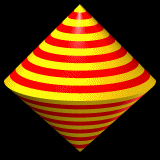Sphericon


The sphericon is a solid that has a continuous developable surface with two congruent semi circular edges, and four vertices that define a square. It is a member of a special family of rollers that, while being rolled on a flat surface, bring all the points of their surface to contact with the surface they are rolling on.[1] It was first introduced by the Israeli game and toy inventor David Haran Hirsch who patented it in Israel in 1980.[2] It was given its name by Colin Roberts, who also explored it.
It may be constructed from a bicone (a double cone) with an apex angel of 90 degrees, by splitting the bicone along a plane through both apexes, rotating one of the two halves by 90 degrees, and reattaching the two halves.
Alternatively, the surface of a sphericon can be formed by cutting and gluing a paper template in the form of four circular sectors (with central angles π/√2) joined edge-to-edge [1].
Ian Stewart of the University of Warwick and Tony Phillips of Stony Brook University have also investigated the sphericon, and it has helped the latter develop theories about mazes.

in the SVG image, move over the image to rotate the shapes
See also
References
- ^ "Mathematical Recreations: Cone with a Twist", Scientific American, October 1999
- ^ David Haran Hirsch (1980): "Patent no. 59720: A device for generating a meander motion; Patent drawings; Patent application form; Patent claims
External links
- Sphericon construction animation at the National Curve Bank website.
- Paper model of a sphericon Make a sphericon
- Sphericon variations using regular polygons with different numbers of sides
- A Sphericon in Motion showing the characteristic wobbly motion as it rolls across a flat surface
